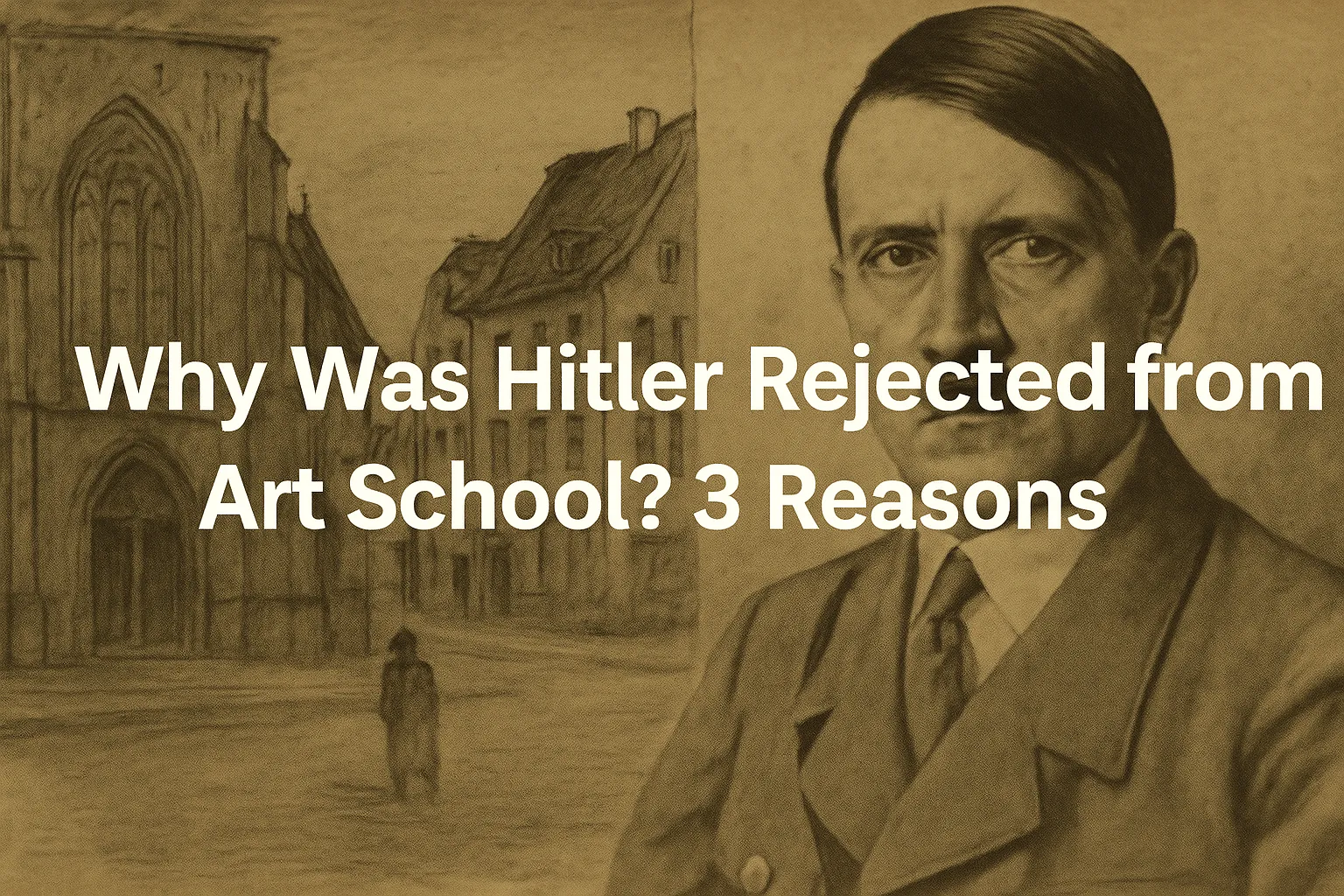Table of Contents
Adolf Hitler, the infamous dictator of Nazi Germany, is known for many things, but few people know about his early aspirations to become an artist. One of the most pivotal moments in Hitler’s early life was his rejection from art school, a decision that shaped his path to power in the years that followed.
In this blog post, we’ll explore why Hitler was rejected from art school, the impact it had on his life, and how this rejection played a role in his later decisions.
A Young Dreamer: Hitler’s Early Passion for Art
Before Adolf Hitler became the notorious leader responsible for some of the most horrific events in modern history, he was a young man with dreams of becoming a professional artist. Born in Braunau am Inn, Austria, in 1889, Hitler developed a passion for drawing and painting at a young age.
His artistic ambitions led him to apply to the Academy of Fine Arts in Vienna, where he hoped to pursue a career in painting.
Hitler’s Artistic Beginnings
Hitler’s early art was primarily influenced by his love for architecture and landscapes. He admired grand historical buildings and picturesque landscapes, often sketching and painting them with a focus on realism. He was especially drawn to watercolor painting, a medium that would dominate much of his work during this period.
His dream was to enter the prestigious Academy of Fine Arts in Vienna, where he believed he could refine his skills and become a renowned artist.
Why Was Hitler Rejected from Art School? 3 Reasons
In 1907, Hitler submitted his application to the Academy of Fine Arts in Vienna, a well-known institution that produced many prominent artists. However, his application was met with rejection, not once, but twice. The reasons behind his rejection are still debated by historians, but several key factors contributed to the decision.
Lack of Artistic Talent
One of the primary reasons for Hitler’s rejection from the art school was the poor quality of his work. Despite his passion for art, Hitler’s technical skills were insufficient to meet the high standards set by the Academy. His paintings, especially his portraits and figure studies, lacked the depth, detail, and precision that the Academy’s examiners were looking for.
Art experts often describe Hitler’s work as flat, with a lack of perspective and depth. His portraits of people were particularly criticized for being overly simplistic, and his compositions lacked the emotional connection that made great art stand out. This lack of skill led to his rejection from the Academy’s painting program.
Inability to Meet the Academy’s Standards
The Academy of Fine Arts in Vienna had rigorous standards for its students. In particular, it placed great emphasis on the ability to draw human figures with anatomical accuracy.
During his entrance exams, Hitler struggled with this aspect of the test. His sketches of the human body were seen as crude and lacking the necessary understanding of anatomy.
Historians note that Hitler’s inability to pass the human figure drawing portion of the exam was a major factor in his rejection. He was told that he should focus on architectural drawings instead of pursuing a career in fine arts. However, this suggestion did not align with Hitler’s artistic desires, and he was deeply disappointed by the rejection.
Personal Circumstances and Emotional Impact
Hitler’s rejection from art school had a profound emotional impact on him. His failure to gain admission to the Academy was a significant blow to his ego, and many historians believe it shaped his resentment toward the art world and, later, toward the elite institutions of society.
Some believe that this rejection played a key role in his development of an intense nationalist ideology, which would later manifest in his political views.
At the time of his rejection, Hitler was also living in Vienna, where he faced financial difficulties and social isolation. His time in Vienna, struggling as an artist, was marked by poverty and frustration.
This period of his life was critical in the development of his worldview, which would later influence his political career and lead to the rise of Nazism.
The Aftermath: How Hitler’s Rejection Shaped His Future
While Hitler’s dreams of becoming a renowned artist were dashed, his rejection from the Academy of Fine Arts did not stop his ambitions. Instead, it seems to have redirected his focus toward politics and power.
In the years following his rejection, Hitler moved to Munich, where he became involved in politics and, eventually, joined the German Workers’ Party, which would later become the Nazi Party.
Historians often suggest that the emotional scars of his early failures, including the rejection from art school, contributed to Hitler’s obsession with control, his authoritarian nature, and his desire to reshape society in his image.
Some theorists argue that the disillusionment with art drove Hitler to seek a more concrete form of legacy, one where he could leave an undeniable mark on history.
The Legacy of Hitler’s Rejection from Art School
Hitler’s rejection from art school may seem like a small event in the context of his later rise to power, but it serves as an important piece of his early life.
The rejection marked the end of his dream of becoming an artist and set him on a completely different path—one that led to his dictatorship and the horrors of World War II and the Holocaust.
His failure in the art world is a poignant reminder of how a single event can influence a person’s life, sometimes in unpredictable and disastrous ways.
For Hitler, the rejection from art school seemed to fuel his resentment toward institutions, authority, and artistic freedom, ultimately contributing to the toxic ideology that he later promoted as the leader of Nazi Germany.
Final Words
Hitler’s rejection from art school is a reminder that personal failure can have a profound impact on an individual’s future. In Hitler’s case, his rejection from the Academy of Fine Arts was not just an artistic failure but a personal one that deeply affected his emotions and worldview.
The story of Hitler’s early rejection is also a powerful lesson in the importance of resilience, self-reflection, and the ability to adapt in the face of setbacks.
While Hitler’s response to rejection led him down a dark and destructive path, it serves as a reminder of the profound effect that early life experiences can have on an individual’s future actions.
In the end, Hitler’s failure to succeed as an artist did not define him. Instead, it shaped the trajectory of his life in ways that would forever change the course of history.

